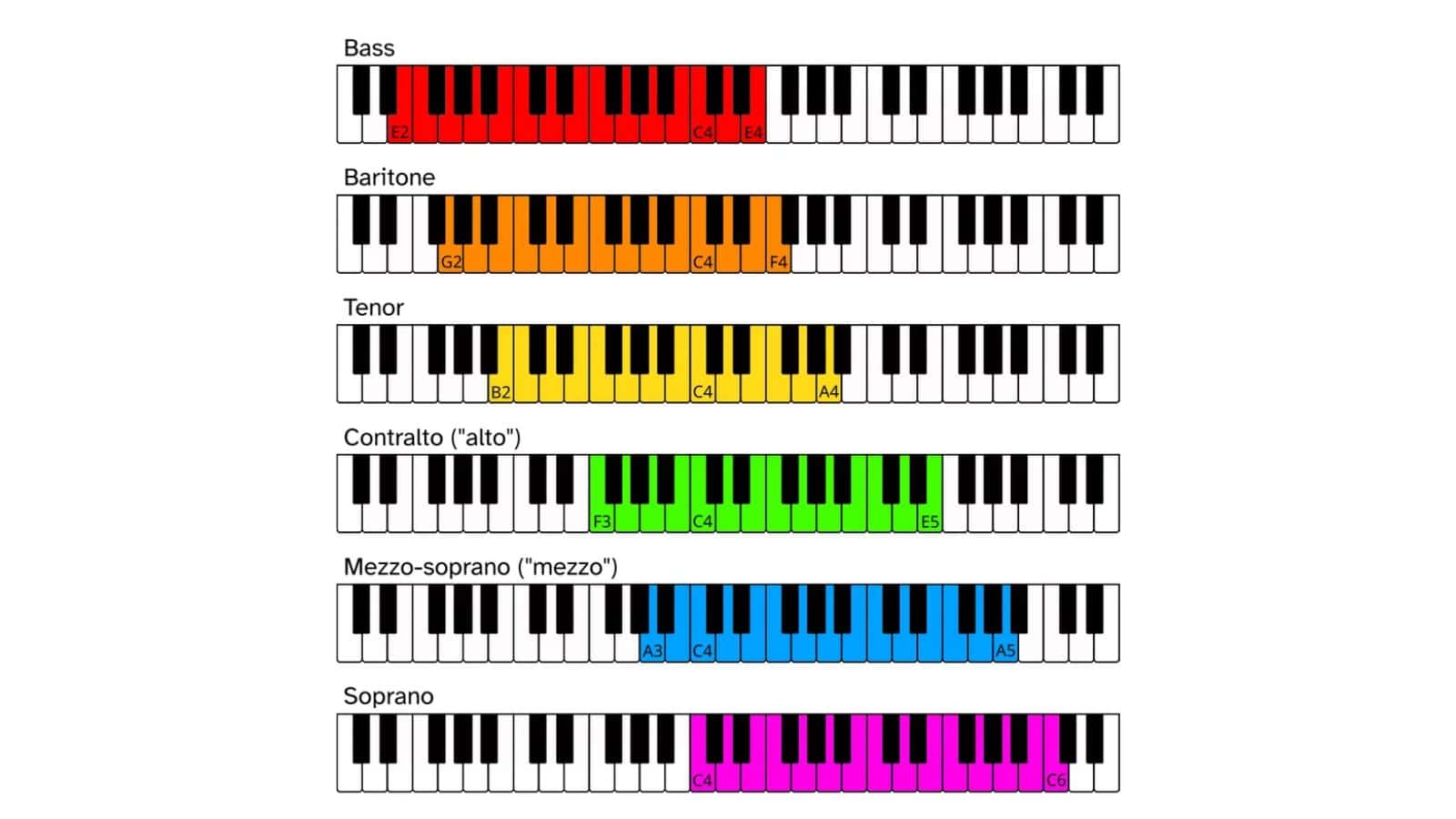
Knowing what key you are singing in is essential because it needs to fit into your natural and comfortable singing range. If you over-extend your voice, you’ll damage your vocal cords, possibly leading to giving up singing altogether in rare cases.
DISCLOSURE: This post may contain affiliate links, meaning when you click the links and make a purchase, we receive a commission.
First, we’ll briefly look at voice ranges before focusing on helping you find your voice range. After that, we’ll look at determining which key you are singing in.
Vocal Ranges
Simply put, your vocal range refers to the range of notes you can sing comfortably. The vocal range is also known as the tessitura in Italian, opera’s native language. We can accurately characterize someone’s voice range by naming the person’s lowest and highest notes.
We commonly use scientific pitch notation to indicate these notes, which is the note’s name and the octave to which it belongs. We may also represent our vocal range by measuring the distance between our range’s lowest and highest notes.
Within the operatic systems of classification, there are six basic voice types. The ranges below are approximations and are not meant to be too rigidly applied.
Female voices:
- Soprano: the highest female voice, able to sing C4 (middle C) to C6 (high C), and possibly higher.
- Mezzo-soprano: a female voice between A3 (A below middle C) and A5 (2nd A above middle C).
- Contralto: the lowest female voice, F3 (F below middle C) to E5 (2nd E above Middle C). In rare instances, Contraltos may have a range comparable to tenors.
Male voices:
- Tenor: the highest male voice, B2 (second B below middle C) to A4 (A above middle C), and possibly higher.
- Baritone: a mid-range male voice, G2 (two Gs below middle C) to F4 (F above middle C).
- Bass: the lowest male voice, E2 (two Es below middle C) to E4 (the E above middle C).
The illustration below shows where each voice type lies on a piano keyboard.

Why Is the Voice Type or Range Important?
Knowing your vocal range will help you choose the ideal key when transposing a song. Remember, melodies are not the same as keys—the key or key signature is not the same as the melody.
A key signature is written with the clef at the beginning of each line of music and is put at the opening of a piece (or the beginning of a section). The key signature reminds the performer of sharps or flats in the piece’s scale (or key).
It also saves time because the composer or arranger doesn’t have to rewrite the sharps or flats every time they occur in the music.
Melody is the arrangement of pitches within a key signature that forms a pleasing sound (depending on your definition of enjoyable) and can span any number of octaves (especially in instrumental music).
Once you know your vocal range, you can transpose a song to the ideal key so that you can sing it comfortably. Avoid concentrating on the new key’s name while picking a higher or lower key.
Instead, focus on the notes you’d have to sing in that transposed key to see if they fit your voice comfortably.
Determining Your Vocal Range
Here’s a quick guide to help you determine your vocal range, and it works for both male and female voice types.
- Go to a guitar or piano or guitar and find Middle C. On the guitar, Middle C is the first fret on the B-string. Sound the note and sing a vowel sound like ‘Ah’ or ‘Oh’ along with the note.
- Make the vowel sound (Ah or Oh) on each note as you move down the keyboard or frets on the guitar. Carry on until you can sing the lowest note without straining your voice. Remember to write this note down.
- Return to Middle C and work your way up until you’ve reached the highest note you can comfortably sing. Write down this note.
- Now you’ve determined your lowest and highest notes, or vocal range (tessitura in Italian). It can look something like this: C3–C5.
If you don’t have a guitar or piano nearby, you can use this vocal range calculator or this video to help you find your vocal range.
What Key Am I Singing In
We’ve focussed a lot on vocal range and determining your vocal range. But sometimes, you need to know what key the song is in, which we’ll look at next.
If you don’t have the sheet music to the song you’re singing, you’ll have to rely on recording yourself and playing it back when you’re at an instrument. Go step-by-step or phrase-by-phrase when trying to figure out the key signature.
See which notes on the piano or guitar match those as you sing. If possible, write it down on manuscript paper (don’t worry too much about putting down a key signature at the beginning yet—you’ll get there).
Some pointers on what to look out for:
- Are there any sharps or flats?
- How many sharps or flats of the same note are you hitting? If you keep getting an F♯ and a C♯, you’re probably in D major if the song sounds happy. If you get just one B♭, you’re perhaps in F major (if the music sounds sad and you also get an occasional C♯, you’re most probably in D minor).
- Now that you’ve determined that you’re, for instance, in D major, write the key signature down at the beginning of the melody you were singing (an F♯ and a C♯) and writing down on manuscript paper.
- To make things more interesting, you can start to transpose the song to other keys, for instance, go a fourth higher to G major. The following is essential when you transpose the song:
Can you still comfortably reach the highest and lowest note without struggling or straining your voice? If not, you’ll have to go down, perhaps to A major, and see how that works.
What happens when you sing the song in another key? Does it still have the same impact, or does it lose that something that made it unique?

